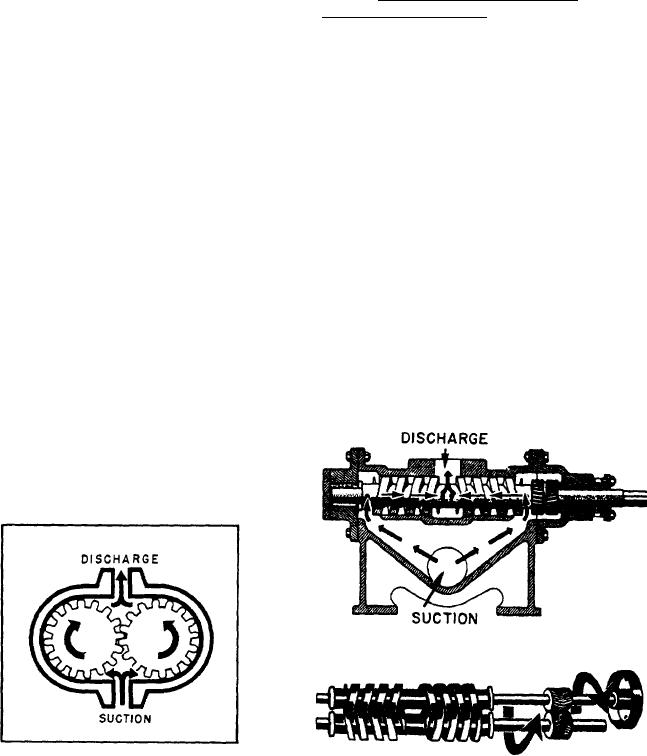
Classification of rotary pumps is generally
straw. As you suck on the straw, you lower the
air pressure inside the straw. Atmospheric
based on the types of rotating element. In the
following paragraphs, the main features of some
pressure on the surface of the liquid surrounding
common types of rotary pumps are described.
the straw is therefore greater and forces
the liquid up the straw. The same conditions
basically exist for the gear and screw pump
GEAR PUMPS.--The simple gear pump
to prime itself. Figure 7-8 shows a gear
( f i g . 7-9) has two spur gears that mesh
p u m p located above the tank. The tank
together and revolve in opposite directions. One
must be vented to allow air into the tank
is the driving gear, and the other is the
to provide atmospheric pressure on the sur-
driven gear. Clearances between the gear teeth
face of the liquid. To lower the pressure
(outside diameter of gear) and the casing and
on the suction side of the pump, the clear-
between the end face and the casing are only a
ances between the pump parts must be close
few thousandths of an inch. As the gears turn,
enough to pump air. When the pump starts,
the gears unmesh and liquid flows into the pockets
the air is pumped through the discharge
that are vacated by the meshing gear teeth. This
side of the pump and creates the low-pres-
creates the suction that draws the liquid into the
sure area on the suction side which allows
pump. The liquid is then carried along in the
the atmospheric pressure to force the liquid
pockets formed by the gear teeth and the casing.
up the pipe to the pump. To operate properly,
On the discharge side, the liquid is displaced by
the piping leading to the pump must have
the meshing of the gears and forced out through
no leaks or it will draw in air and can
the discharge side of the pump.
lose its prime.
One example of the use of a gear pump is in
Rotary pumps are useful for pumping oil and
the LM2500 engine fuel pump. However, gear
other heavy viscous liquids. In the engine room,
pumps are not used extensively on gas turbine
rotary pumps are used for handling lube oil and
ships.
fuel oil and are suitable for handling liquids over
a wide range of viscosities.
Rotary pumps are designed with very
SCREW PUMPS.--Several different types
small clearances between rotating parts and
of screw pumps exist. The differences be-
stationary parts to minimize leakage (slippage)
tween the various types are the number of
from the discharge side back to the suction
intermeshing screws and the pitch of the screws.
side. Rotary pumps are designed to operate
Figure 7-10 shows a double-screw, low-pitch
at relatively slow speeds to maintain these
clearances; operation at higher speeds causes
erosion and excessive wear, which result in
increased clearances with a subsequent decrease
in pumping capacity.
Figure 7-9.--Simple gear pump.
Figure 7-10.--Double-screw, low-pitch pump.
7-9

